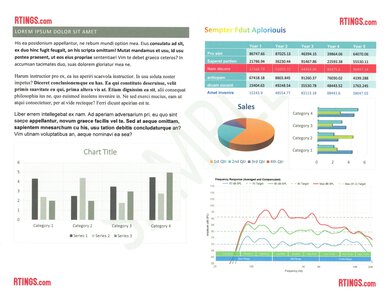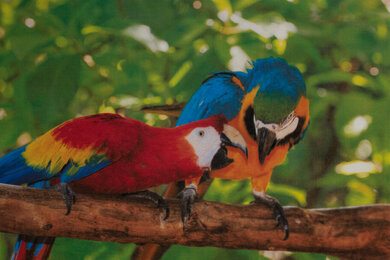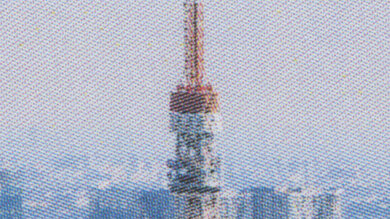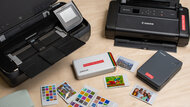The Brother MFC-L3780CDW is an all-in-one color laser printer. It's effectively a replacement for the Brother MFC-L3770CDW; while the two printers share a similar design, the newer model uses different TN229 cartridges and drum units. It's also fully compatible with TN229XL high-yield and TN229XXL super high-yield cartridges. It has a flatbed scanner with an ADF and single-pass duplex scanning capability. Its connectivity options include USB, Wi-Fi, and Ethernet, and it can also print directly off a USB flash drive.
Our Verdict
The Brother MFC-L3780CDW is very good for family use. It might be a little large to squeeze into most homes, but it does offer a plethora of features. It incurs little in the way of ownership costs thanks to its high page yield, outputs remarkably sharp, detailed prints, and has a flatbed scanner with a height-adjustable lid that's fantastic for digitizing pages from books and magazines. Unsurprisingly, for a laser printer, it isn't a great option for printing photos.
-
High page yield.
-
Fantastic document printing quality.
-
Full-featured scanner.
-
Wide variety of connectivity options.
-
Limited color gamut.
-
Poor color accuracy.
-
Bulky for at-home use.
The Brother MFC-L3780CDW is excellent for home offices. Its standard TN229 cartridges are sufficient for regular printing, but if you need more, you can buy high-yield and super high-yield toner cartridges. While it might take a little while to warm up, it can print a lot of pages in a hurry once it has, which is great for high-volume print jobs. Most of its components, like the drum unit, belt unit, and waste toner box, have a long service life and are easy to replace. Overall print quality is also fantastic.
-
High page yield.
-
Fantastic document printing quality.
-
Rapid printing speed.
-
Full-featured scanner.
-
Wide variety of connectivity options.
-
Slow to warm up.
The Brother MFC-L3780CDW is great for students, even if it's on the pricey side and a little too big to fit in most dorm rooms. It prints very quickly, which is great if you're running late on an assignment, and outputs very high-quality documents. Its standard-size toner cartridges have a high enough page yield for a full semester of printing and aren't all that expensive, though higher-yield TN229XL and TN229XXL cartridges are available if you have a larger print load. Its scanner also does a fantastic job of digitizing documents.
-
High page yield.
-
Fantastic document printing quality.
-
Rapid printing speed.
-
Full-featured scanner.
-
Wide variety of connectivity options.
-
Bulky for at-home use.
The Brother MFC-L3780CDW is an amazing option for black-and-white printing. It produces sharp documents, prints quickly, and yields a large number of prints. It also boasts a flatbed scanner with an ADF that can quickly process long double-sided documents thanks to its single-pass duplex scanning capability. It feels incredibly well-built, and maintenance is straightforward, as all the consumable parts are easily replaceable. Also, you can buy the high-yield black toner cartridge in twin packs, which is cheaper than buying them separately.
-
High page yield.
-
Fantastic document printing quality.
-
Rapid printing speed.
-
Slow to warm up.
The Brother MFC-L3780CDW is a poor choice for photo printing, though this isn't really what it's designed for. It has a limited color gamut and poor color accuracy. Its printing pattern is rather obvious and obscures fine details in photos. Finding compatible glossy photo paper is also a challenge.
-
High page yield.
-
Limited color gamut.
-
Poor color accuracy.
-
Not compatible with the majority of glossy photo paper.
-
High page yield.
-
High page yield.
-
High page yield.
-
High page yield.
-
High page yield.
- 7.9 Family
- 8.8 Small/Home Office
- 8.4 Student
- 8.7 Black & White
- 4.3 Photo
Performance Usages
- 4.5 Color Quality
- 9.5 Document Quality
- 9.6 Scanner
- 8.2 Speed
- 8.2 Recurring Costs
Changelog
-
Updated Dec 17, 2024:
Added mention of the HP Color LaserJet Pro MFP 3301fdw as an alternative that prints faster in the Printing Speed box.
- Updated Jan 10, 2024: Added mention of the HP Color LaserJet Pro MFP 4301fdw/4301fdn as an alternative with faster printing speeds in the Printing Speed section.
- Updated Dec 18, 2023: Review published.
- Updated Dec 06, 2023: Early access published.
- Updated Dec 04, 2023: Our testers have started testing this product.
Check Price
Differences Between Sizes And Variants
We tested the Brother MFC-L3780CDW all-in-one printer. There are a few other variants with slightly different features; you can see the differences between them in the table below.
| Model | Duplex Scanning | Connectivity | Toner Cartridge Compatibility | Advertised Printing Speed (Black/Color) | Input tray | Region of Sale |
|---|---|---|---|---|---|---|
| Brother MFC-L3720CDW | N |
Wi-Fi, USB |
TN229, TN229XL |
19 PPM / 19 PPM |
Single-sheet manual feeder | North America |
| Brother MFC-L3760CDW | N | Wi-Fi, Ethernet, USB, External Storage (USB flash drive) | TN258, TN258XL | 27 PPM / 27 PPM | Single-sheet manual feeder | Europe/Oceania |
| Brother MFC-L3765CDW | N | Wi-Fi, Ethernet, USB, External Storage (USB flash drive) | TN229, TN229XL | 27 PPM / 27 PPM | Single-sheet manual feeder | North America |
| Brother MFC-L3780CDW | Y |
Wi-Fi, Ethernet, USB, External Storage (USB flash drive), NFC |
TN229, TN229XL, TN229XXL |
31 PPM / 31 PPM |
30-sheet multi-purpose tray and optional 250-sheet input tray | North America |
| Brother MFC-L8340CDW | N | Wi-Fi, USB, External Storage (USB flash drive) | TN248, TN248XL | 31 PPM / 31 PPM | 30-sheet multi-purpose tray | Europe |
| Brother MFC-L8390CDW | Y | Wi-Fi, Ethernet, USB, External Storage (USB flash drive), NFC | TN258, TN258XL | 31 PPM / 31 PPM | 30-sheet multi-purpose tray and optional 250-sheet input tray | Europe/Oceania |
You can see our unit's label here.
Compared To Other Printers
The Brother MFC-L3780CDW is a great all-in-one color laser printer. It's a step up from the older Brother MFC-L3770CDW Laser, as it has an improved cartridge system with longer-lasting drum units, not to mention superior print and scan quality.
If you're looking for alternatives, see our recommendations of the best laser printers, the best office printers, and the best all-in-one printers.
The HP Color LaserJet Pro MFP 3301fdw and the Brother MFC-L3780CDW/MFC-L3720CDW are feature-rich, all-in-one laser printers. Both produce sharp documents and yield thousands of prints per cartridge. If you need to scan many documents, the Brother is a better choice; it offers significantly better scan quality, and its ADF can process sheets faster and offers built-in OCR. If you primarily print black-and-white documents, the HP is a better bet, as it can push 26 pages per minute to the Brother's 20.
The Brother MFC-L3780CDW is a slightly better overall printer than the Canon Color imageCLASS MF753Cdw, though the differences between the two aren't especially huge. The Brother's scanner processes documents faster, and it incurs lower ownership costs thanks to its less expensive toner cartridges. That said, the Canon has an easier-to-use display interface, and it has a faster max printing speed.
The Canon Color imageCLASS MF656Cdw and Brother MFC-L3780CDW each have their own advantages. The Canon has a larger touchscreen display, uses cartridges with a greater page yield, and offers marginally better color accuracy and fine detail reproduction in photos, though neither printer should be your first choice if you're planning on printing photos regularly. On the other hand, the Brother's ADF-equipped scanner processes sheets faster, and out-of-the-box printed documents are less noticeably over-saturated than they are from the Canon.
The HP Color LaserJet Pro MFP 4301fdw/4301fdn and the Brother MFC-L3780CDW/MFC-L3720CDW are both color laser printers with near-identical features. The HP prints and scans faster; however, the Brother's scanner is more feature-rich, as it has adjustable lid hinges and built-in OCR (optical character recognition). Although the HP yields more print, it might still cost more in replacement toner over time because the cartridges are significantly more expensive.
The Brother MFC-L3780CDW is an improvement on the Brother MFC-L3770CDW. The MFC-L3780CDW features drum units for its toner cartridges that don't expire prematurely, and it delivers slightly better print and scan quality.
The Brother HL-L2380CDW and the Brother MFC-L3780CDW are very similar regarding print quality and yield; however, the former is a print-only unit, while the latter is an all-in-one with a scanner. The MFC-L3780CDW technically prints black-and-white documents faster, but only when using a wired USB connection, as its printing speed drops considerably when printing over Wi-Fi. The MFC-L3780CDW has more connectivity options, including support for NFC and external storage drives (USB), though you can get a variant of HL-L3280CDW with the same features.
The Brother MFC-L8905CDW is ultimately a better overall laser printer than the Brother MFC-L3780CDW, though the MFC-L3780CDW is ultimately still a good option if you don't want to spend quite as much. The MFC-L8905CDW uses cartridges with a significantly higher page yield, has an ADF for its scanner with a larger-capacity input tray and faster scan speed, and prints documents faster.
Test Results
The build quality is superb. It's made mainly from hard, dense plastic. The input and output trays are well-designed, with sturdy tabs to hold paper in place. You can easily access the sheet rollers through the cartridge bay or via a port at the back of the printer. Unfortunately, the control screen is at a fixed angle, so it can be hard to see if you aren't looking at it directly.
The Brother MFC-L3780CDW is a laser printer, so you don't need to worry about printheads clogging the way you do with inkjet models. There are a few components that need periodic replacement, but, thankfully, these items are easily accessible and readily available from the manufacturer.
- Cartridges/Drum Units: You can access the cartridges by lifting the top of the printer and simply pulling them out of their respective slots. As seen here, the drum units aren't integrated with the cartridges, so you have to replace them separately. They have an estimated lifespan of 20,000 pages. You can only buy them in packs of four from the manufacturer, seen here. This can be problematic if one of the four wears out prematurely or gets damaged.
- Belt Unit: The belt unit is under the cartridges and the drum. You can remove it by pulling the green release lever. It has an estimated service life of 50,000 pages; you can get a replacement here.
- Waste Toner Box: The waste toner box is under the belt and removable by pulling on the green handle. It also has an estimated service life of 50,000 pages. You can buy a replacement from the manufacturer here.
The fuser unit and paper feeding kit also need periodic replacement, though it's best to enlist the services of a professional to replace these components since doing so requires some disassembly. If you need to clear out any paper jams, you can access the sheet rollers by either going through the door at the back of the printer, removing the cassette tray, or by lifting the scanner.
See the user manual here.
The Brother MFC-L3780CDW's display is excellent, with a few caveats. It's relatively large, touch-sensitive, and is responsive to inputs. The virtual keyboard that comes up whenever you need to enter passwords or punch in file names for scans has large keys, so you won't accidentally press the wrong symbol. That said, while it has good viewing angles, it's in a fixed position, so it can be hard to see if you're seated.
This printer's cartridge system is excellent. Its standard TN229 cartridges are more than sufficient for regular printing at home, though if you're regularly printing at high volumes for office work, you'll probably want to invest in high-yield TN229XL, which have an advertised yield of 3,000 black or 2,300 color prints, or super high-yield TN229XXL cartridges, which have an advertised yield of 4,500 black or 4,000 color prints.
Unfortunately, the printer won't output pages with an empty black toner cartridge, though you can still scan documents. On the upside, you'll have ample warning that you're running low; you'll see a banner notification on the screen when you're running low, which links to a real time estimate of remaining toner levels as well as a splash page for its Refresh ink subscription program. The printer will also provide a multi-step slideshow showing you how to replace a toner cartridge (1, 2, 3).
This printer has a scanner with a remarkably broad range of features. It has an automatic document feeder with automatic single-pass duplex scanning capability, making it easy to process long and two-sided documents. Additionally, the scanner's lid has hinges that can extend to accommodate thicker documents or books. The printer has optical character recognition; however, you need to initiate the scan from your computer if you want to save the scan as a searchable PDF. Initiating an OCR scan from the printer only allows you to save the file as a txt, HTML, or RTF file.
The scan quality is superb. Scanned text is very legible, and fine details are clearly visible. There's also less obvious graininess when looking at highly saturated areas compared to scans from the Brother MFC-L3770CDW Laser.
Note: The sample scan's color reproduction isn't the same as scans from other printers we've tested, as it has a slightly greenish tinge. This isn't an issue with the printer but rather the sample document itself. We're looking to resolve this issue in testing. As such, we've scored the scan quality without consideration for color accuracy.
The Brother MFC-L3780CDW is a corded printer with no battery.
The black-and-white print quality is superb. Printed text is sharp, and fine details are clearly visible. There isn't much graininess, and lighter colors, like yellow, that have been converted to grayscale don't look very faint, with clear delineation to similar shades.
The print quality of color documents is also fantastic. Printed text is legible, and you can easily identify most fine details. Color reproduction is also fairly accurate, especially compared to the Brother MFC-L3770CDW Laser, which tended towards over saturation.
Printing artifacts might appear when using the 'Document: Mixed' setting. If you look at the sample print outputted using this setting (as opposed to the 'Document: Standard' mode sample above), you can see a faint pink rectangle around the pie chart. This same sort of artifact was present on sample prints from the Brother MFC-L3770CDW Laser. Let us know in the discussions below if you have this printer and encounter the same issue.
The cost-per-print is impressively low, though far from earth-shattering compared to a lot of other high-end business-grade laser printers. Replacement cartridges are fairly close in price to the TN-227 toner cartridges used by the Brother MFC-L3770CDW Laser, but the printer itself is a little more expensive.
The printing speed is great. The printer is a little slow to warm up, but once it does, it can output pages very quickly. We could only get close to its advertised output of 31 PPM (black) when connected via USB, which nets a print speed of 30 PPM. Printing over Wi-Fi drops its black-only print speed to 20 PPM due to buffering. That said, your experience may vary. If you want a color laser printer with faster printing speeds, check out the HP Color LaserJet Pro MFP 4301fdw/4301fdn or the HP Color LaserJet Pro MFP 3301fdw.
The MFC-L3780CDW and Brother MFC-L8390CDW have a 30-sheet multi-purpose tray, and they support an additional (optional) 250-sheet input tray, which you can buy here. The Brother MFC-L3720CDW, MFC-L3760CDW, and MFC-L3765CDW variants don't support the optional input tray and only have a single-sheet manual feeder instead of a multi-purpose tray.
This printer's main paper tray accepts plain paper, thin paper, thick paper, and recycled paper. The multi-purpose tray can take all of those paper types along with bond, label, thick/thin/standard envelope, and glossy paper too.
This printer tends to curl sheets at a higher rate than other laser printers, and unlike some alternatives, those sheets tend to stay curled instead of straightening out over time.
This printer has a poor color gamut. It can't produce bright, saturated colors, and it struggles with darker shades of green and yellow. Its narrow color range makes photos look flat and lacking in detail. There's plenty of banding in the lighter shades, and color transitions look very grainy due to the printing pattern.
This printer is bad at reproducing small details. It prints at a low resolution, and like most laser printers, the printing pattern is very noticeable and causes the loss of fine details, to a greater degree than the older Brother MFC-L3770CDW Laser. The default print resolution (labeled 'Fine') is 2400 dpi. The 'Regular' resolution is 600 dpi; here's a sample printed at that resolution.
Note: The suggested variety of glossy paper for this printer is NewPage Futura Laser Gloss 80 lb Text paper. Unfortunately, this kind of paper is very difficult to find, with the only accessible format being highly expensive 11 x 17 sheets. The limited availability of compatible glossy paper, combined with the fact that this printer isn't really designed for photo printing, led us to set the 'Glossy Paper' result fields to 'No'.
This printer can print files directly off of a USB flash drive. You can see a close-up view of each of the printer's ports below:
The Brother MFC-3780CDW and MFC-L8390CDW support NFC, allowing you to connect an NFC-enabled device by tapping it against the printer. The Brother MFC-L3720CDW and the Brother MFC-L8340CDW lack Ethernet support. Additionally, the MFC-3720CDW can't print from a USB flash drive.
The Brother Mobile Connect app is superb. You can print and scan documents from the app directly to your mobile device, even when you're away from home, manage your Refresh EZ Print toner subscription, or purchase toner cartridges.
You don't need to install any drivers to print or scan on Chrome OS and macOS devices, but you do on Windows devices. You can download the drivers here.
Comments
Brother MFC-L3780CDW/MFC-L3720CDW: Main Discussion
Let us know why you want us to review the product here, or encourage others to vote for this product.
- 21010
# Errors and Omissions in Review This review is incorrect. I have the L3780 and it absolutely can scan with OCR, creating a searchable PDF, directly via the printer. No computer or other device is needed. It can even scan directly to your favoured cloud service (dropbox, google drive, one drive, evernote, box etc), with OCR and as a PDF, no computer necessary. This review falsely stated that OCR scans initiated from the printer can only be saved to txt, html or rtf. This is not the case. Searchable PDF is also an option. It also has an “easy scan to email” feature which lets you scan to email (again with OCR) without having to manually set up an email server. All you have to enter is the destination email address and your preferred scan settings. It’s bad enough that these excellent on-device, OCR, direct-to-cloud scanning features, which are extremely rare (especially with OCR) are not even mentioned in the review. But to falsely claim that scanning to PDF with OCR directly via the printer is not even supported? That’s criminal. I’m confused how one of the marquee features of this printer, one that truly makes it stand out among the pack, was completely overlooked.
More Thoroughness in Evaluating Scanning and AIO Features
I also would appreciate more thoroughness in reviewing the scanning features. For example, while the monochrome Brother MFC L2900 (similar to L2880 and L2920) supports the cloud and on-device OCR scanning features like the MFC L3780, only the L3780 supports the ability to automatically filter out blank pages. In practice this means that the L2900 series must have separate shortcuts for 2 sided and 1 sided scans, unless you want to have a blank page in between every page of a 1 sided ADF document scan. The L3780 on the other hand has a feature to auto detect blank pages, meaning that the user can always scan with “2 sided” enabled and the document will come out properly regardless. These kinds of distinctions are very important but not covered in either printer review.
Lack of Coverage of Fax Features
Finally, the fax section is basically non-existent. It just says fax: yes. That’s quite shabby. For example, at a minimum the review should mention that while both PC and Mac users can “Print to Fax”, the ability to receive faxes is only supported on Windows. Brother does not support receiving faxes on Macs at all. This was not covered in the review, and the review falsely stated that the drivers and software were both fully compatible with Windows, macOS (and even chrome OS). Fortunately, the user can use the leading edge cloud features to have faxes automatically uploaded to the cloud, which can then immediately sync with a folder in the finder for Mac users. But again, those features also were neglected in this review. Overall, really appreciate the work Rtings does. But I hope some of this feedback gives some ideas for how the site can improve even further. Thanks for the good work!
Sorry for the delay on our end. We were hoping to conduct our retests before getting back to you but we’ve had a large queue to work through. We’re going to look into this, and we’ll update our review accordingly. Thanks again for sharing your thoughts with us, and apologies again for the delays.
- 21010
Errors and Omissions in Review
This review is incorrect. I have the L3780 and it absolutely can scan with OCR, creating a searchable PDF, directly via the printer. No computer or other device is needed. It can even scan directly to your favoured cloud service (dropbox, google drive, one drive, evernote, box etc), with OCR and as a PDF, no computer necessary. This review falsely stated that OCR scans initiated from the printer can only be saved to txt, html or rtf. This is not the case. Searchable PDF is also an option. It also has an “easy scan to email” feature which lets you scan to email (again with OCR) without having to manually set up an email server. All you have to enter is the destination email address and your preferred scan settings.
It’s bad enough that these excellent on-device, OCR, direct-to-cloud scanning features, which are extremely rare (especially with OCR) are not even mentioned in the review. But to falsely claim that scanning to PDF with OCR directly via the printer is not even supported? That’s criminal. I’m confused how one of the marquee features of this printer, one that truly makes it stand out among the pack, was completely overlooked.
More Thoroughness in Evaluating Scanning and AIO Features
I also would appreciate more thoroughness in reviewing the scanning features. For example, while the monochrome Brother MFC L2900 (similar to L2880 and L2920) supports the cloud and on-device OCR scanning features like the MFC L3780, only the L3780 supports the ability to automatically filter out blank pages. In practice this means that the L2900 series must have separate shortcuts for 2 sided and 1 sided scans, unless you want to have a blank page in between every page of a 1 sided ADF document scan. The L3780 on the other hand has a feature to auto detect blank pages, meaning that the user can always scan with “2 sided” enabled and the document will come out properly regardless. These kinds of distinctions are very important but not covered in either printer review.
Lack of Coverage of Fax Features
Finally, the fax section is basically non-existent. It just says fax: yes. That’s quite shabby. For example, at a minimum the review should mention that while both PC and Mac users can “Print to Fax”, the ability to receive faxes is only supported on Windows. Brother does not support receiving faxes on Macs at all. This was not covered in the review, and the review falsely stated that the drivers and software were both fully compatible with Windows, macOS (and even chrome OS). Fortunately, the user can use the leading edge cloud features to have faxes automatically uploaded to the cloud, which can then immediately sync with a folder in the finder for Mac users. But again, those features also were neglected in this review.
Overall, really appreciate the work Rtings does. But I hope some of this feedback gives some ideas for how the site can improve even further. Thanks for the good work!
This product has been merged with Brother MFC-L3720CDW Wireless Digital Color All-in-On. Follow the discussion here.
- 21010
I am curious what the maximum dpi is for the ADF scanner vs the flatbed. My current HP only allows 300 max dpi in the ADF and I’d like to upgrade to something that is higher.
Hello @Akapterian, Thanks for your comment! The ADF’s has a maximum resolution of 600 DPI, while the flatbed’s is 1200 DPI. Hope this helps!
- 21010
I am curious what the maximum dpi is for the ADF scanner vs the flatbed. My current HP only allows 300 max dpi in the ADF and I’d like to upgrade to something that is higher.
Update: Added mention of the HP Color LaserJet Pro MFP 3301fdw as an alternative that prints faster in the Printing Speed box.
- 21010
Does the scan quality rating apply to the flatbed or document feeder or both? I’m waiting for results on the HP 4301 as well and wanting to compare scan quality of the ADF because I’m wanting to digitize all my paper mail documents. I did notice that with my 4301 (trying it out) that when you use the ADF to scan as PDF and the print the PDF, it comes out a little blurry. But when you do a straight copy on the machine (using ADF still) it comes out more sharp/clear. As far as I know the setting in the HP software had PDF compression set to none. Also the HP 4301 ADF is 300 DPI while the Brother 3780 is 600. I don’t know how much difference this will make. It could be significant when it comes to the small print. But I am going to order either the 3780 or the 8905 and compare them to the HP. Just not sure which one to order, as the 3780 is newer, uses LED printing, and the 8905 has finer motor increments for both scanners (don’t know if that matters either). Overall I just want the higher quality machine that will give me best results. Any insight beyond the testing data is helpful. Thanks.
Still wanting to know if the scan quality ratings apply to the ADF or not. Thanks!
Edited 1 year ago: typo












































